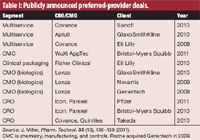Strategies for Preferred-Provider Partnerships
The author examines recent examples of preferred-provider collaborations.
As pharmaceutical companies increase their level of outsourcing, the models for partnering ar evolving. Preferred-provider relationship are highly collaborative and strategic partnerships between pharmaceutical companies and select CROs, CDMOs, and CMOs. The author examines recent examples of such collaborations.
Facing pressure to improve timelines in drug development and reduce costs in drug development and commercialization, the pharmaceutical majors are increasing their level of external development and manufacturing. At the same time, they are looking to manage these external relationships more efficiently and cost-effectively. The result is the preferred-provider relationship in outsourcing. Unlike simple transactional or fee-for-service outsourcing, preferred-provider relationships represent a deeper, more collaborative, and enhanced strategic partnership between sponsor companies and their third-party providers and satisfy an interest by pharmaceutical companies to work with fewer suppliers. During the past several years, select pharmaceutical majors have entered into preferred-provider relationships, particularly with CROs, although manufacturing-based relationships also have been formed.

Kutay Tanir/ Photodisc /Getty Images
Big Pharma partners
Pfizer. In May 2011, Pfizer formed strategic partnerships with the CROs Icon and Parexel, both of which will serve as strategic providers of clinical-trial implementation services over a five-year period beginning in June 2011. The new partnerships will be fully implemented over an 18-to-24 month period.
In announcing the collaborations with Icon and Parexel, Pfizer said that the two-partner model will simplify its processes by reducing the number of external service providers that the company uses for clinical-trial execution. Pfizer says this new strategic partnership model does not substantially change the proportion of clinical-trial implementation services that the company outsources. Pfizer is retaining scientific ownership of the clinical-development process and is maintaining oversight and quality standards relating to patient safety and regulatory compliance.
"We've also [have] taken a look at the value chain inside our research organization and have outsourced a lot of our clinical work with a strategic partnership with Icon and Parexel," said Ian Read, chairman and CEO at Pfizer at the JPMorgan Healthcare Conference, which was held in January 2012 (1). "I think that's a major strategy for us. We've rationalized our efforts there. Before we were dealing with 18, 19, 20 plus partners. It was very difficult to control. It was very difficult to get quality work and get savings. We now have a strategic partnership with two global players."
Bristol-Myers Squibb. Pfizer's partnership with Icon and Parexel followed an earlier partnership made by Bristol-Myers Squibb with Icon and Parexl. In June 2010, Bristol-Myers Squibb signed three-year agreements with Icon and Parexel for joint strategic, operational, and capability support of Bristol-Myers Squibb's clinical-development program. In August 2011, Bristol-Myers Squibb selected Icon as a preferred provider for full-service clinical pharmacology and exploratory clinical studies

Table I: Publicly announced preferred-provider deals.
Bristol-Myers Squibb has since followed with other preferred-provider arrangements. In March 2011, Bristol-Myers Squibb and the CRO WuXi AppTec formed a strategic partnership for stability studies of small-molecule new chemical entities. Under the agreement, WuXi will build, equip, and operate a dedicated, fully cGMP-compliant 25,000-ft2 analytical testing facility in Shanghai to store and test stability samples and to perform other services for Bristol-Myers Squibb. WuXi also will employ a dedicated staff for stability testing, sample management, analytical testing, pharmaceutical science, quality assurance, metrology, and other services, including stability-data reporting in support of all global dossier submissions by Bristol-Myers Squibb.
Bristol-Myers Squibb also had adopted a facility component in its preferred-provider relationship with Syngene International, a subsidiary of the Indian biotechnology company Biocon. In March 2009, Syngene opened a fully dedicated R&D facility for Bristol-Myers Squibb in Bangalore, India. The 200,000-ft2 facility is focused on discovery and early-drug development. Construction on the facility began in March 2007 when Bristol-Myers Squibb and Biocon entered into an agreement to develop integrated drug-discovery and development capabilities at Syngene.
Sanofi. In October 2010, Sanofi and the CRO Covance finalized a 10-year, $2 billion R&D alliance, which included an asset and staff transfer of two R&D facilities and approximately 300 associated scientific and technical staff. Under the agreement, Sanofi sold its Porcheville, France, and Alnwick, United Kingdom, sites and facilities to Covance for approximately $25 million. Under the agreements, Sanofi is using Covance's global R&D portfolio of discovery support, toxicology, chemistry, clinical Phase I–IV, central-laboratory, and market-access services with annual commitments for these services increasing over the next decade. These agreements included a 10-year sole-source relationship for central-laboratory services. Covance gained chemistry, manufacturing, and controls (CMC) services with the addition of the Porcheville and Alnwick sites, including preformulation, drug formulation, preclinical, early-stage clinical API manufacturing, and radiolabeled chemistry. When announced in 2010, Covance expected the alliance to generate revenues between $1.2 billion and $2.2 billion.
Eli Lilly. Covance's partnership with Sanofi followed another long-term, high-value partnership with Eli Lilly. In August 2008, Eli Lilly and Covance entered into a long-term strategic alliance in which Covance acquired Eli Lilly's preclinical research facility in Greenfield, Indiana, for $50 million. As part of the agreement, Covance hired 264 former Eli Lilly employees, and Eli Lilly committed to providing $1.6 billion in work to Covance over 10 years for a broad range of drug-development services. Covance also assumed responsibility for all of Lilly's toxicology testing and discovery support activities at Greenfield.
Eli Lilly has further used the preferred-provider model in its clinical-trial-materials supply activities. In March 2010, Thermo Fisher Scientific expanded its clinical-trial material supply relationship with Eli Lilly as part of a new, five-year agreement. Under the agreement, Fisher Clinical Services, a business of Thermo Fisher, took over responsibility for Eli Lilly's in-house clinical-trial-materials manufacturing, packaging, and labeling operations onsite at the Lilly Technology Center North in Indianapolis, Indiana. Fisher Clinical Services also is handling the distribution of clinical-trial materials for Eli Lilly throughout North America. The agreement included Fisher Clinical Services' purchase of Lilly's clinical-trial manufacturing and packaging equipment. This relationship was expanded to support Lilly's new operating model, which is designed to speed drug development while reducing fixed costs.
Eli Lilly adopted a preferred-provider approach in API manufacturing as well. In January 2010, Eli Lilly finalized the sale of its Tippecanoe Laboratories API manufacturing facility in Lafayette, Indiana, to Evonik Industries in a deal first announced in 2009. The facility produces APIs, fine chemicals, and animal-health products. In connection with the sale of the site, the two companies entered into a nine-year supply and services agreement, whereby Evonik will manufacture final APIs and intermediates for certain Eli Lilly human and animal-health products. The sale of Tippecanoe Laboratories was the culmination of Lilly's strategic review of the site that was announced in July 2008. The decision to sell the site was based upon a projected decline in utilization of the site due to several factors, including upcoming patent expirations on certain medicines made at the site, Lilly's strategic decision to purchase, rather than manufacture, many late-stage chemical intermediates, and the evolution of the Lilly pipeline toward more biotechnology medicines.
GlaxoSmithKline. Two preferred-provider relationships from GlaxoSmithKline (GSK) involve manufacturing with the CMO Lonza and R&D with the CDMO Aptuit. On the manufacturing side, GSK partnered with Lonza in September 2010 for securing capacity and expertise in biological manufacturing by which Lonza is supplying manufacturing capacity for five early-stage monoclonal antibodies of GSK.
Under the terms of the agreement, Lonza will initially manufacture clinical-trial batches of five compounds currently in Phase I and II for GSK. Lonza also will provide access to flexible capacity to enable GSK to respond to future demand dependent upon progression of the molecules through late-stage development and commercial launch. As part of the agreement, GSK will work with Lonza to assess options for the design, specification, location, and construction of a biopharmaceutical manufacturing facility within the UK.
On the R&D side, in July 2010, GSK and Aptuit finalized an agreement under which Aptuit acquired operations at GSK's Medicines Research Center in Verona, Italy, for supplying R&D services to GSK. Aptuit gained the scientific expertise and knowledge of approximately 500 staff at the research center through the transfer of the facility. The agreement allows Aptuit to combine its expertise with the Verona Medicines Research Center's expertise in drug discovery, lead optimization, API development and manufacturing, and preclinical and clinical drug development.
Other relationships
Although the high-profile deals with the pharmaceutical majors garner much of the attention in preferred-provider partnerships, smaller bio/pharmaceutical companies also may use this model with their outsourcing partners. For example, in January 2012, AMRI, a contract research and manufacturing organization, entered into a preferred-provider agreement with BioPontis Alliance, an asset-based investment capital fund and R&D company that has scientific alliances with research universities. BioPontis focuses on developing treatments for cancer, neurology, inflammation, and infectious diseases.
The BioPontis Alliance has agreements with New York University, Columbia University, Memorial Sloan–Kettering Cancer Center, University of Pennsylvania, University of North Carolina (Chapel Hill), University of Virginia, University of Kansas, Oregon Health and Sciences University, Thomas Jefferson University, and the University of Florida. In addition to these partnerships aimed at identifying early technology, BioPontis has entered into preferred-partnership agreements with pharmaceutical companies, including Janssen Biotech (wholly owned by Johnson & Johnson), Pfizer, and Merck & Co.
The goal of the BioPontis Alliance is to identify promising early-stage product opportunities and use a preferred network of CROs and research companies to apply appropriate expertise to develop these opportunities enough to attract pharmaceutical companies as licensing partners. Under BioPontis Alliance's agreement with AMRI, AMRI will provide its services in small-molecule discovery, development, and manufacturing in support of BioPontis' drug-discovery research programs and need for proof-of-concept data that is required for pharmaceutical-company licensing.
In September 2011, the regenerative-medicine company Mesoblast and Lonza entered into a strategic alliance for clinical and long-term commercial production of Mesoblast's off-the-shelf (allogeneic) adult stem-cell products. The alliance provides Mesoblast with certainty of capacity to meet long-term global supply of its proprietary Mesenchymal Precursor Cell (MPC) products. Under the agreement, Lonza will supply Mesoblast's clinical and long-term commercial MPC product needs globally. Mesoblast can trigger a process requiring Lonza to construct a purpose-built manufacturing facility exclusively for Mesoblast's marketed products. In return, Mesoblast will purchase agreed quantities of marketed products from the facility. Mesoblast can exercise its right to buy out this manufacturing facility at a pre-agreed purchase price two years after the facility receives regulatory approval. Mesoblast will have exclusive access to Lonza's cell-therapy facilities in Singapore for the manufacture of allogeneic cell-therapy products, subject to certain exceptions. Lonza will use its proprietary intellectual property to facilitate reductions in Mesoblast's manufacturing costs and help enable development of enhanced second-generation products.
Although not strictly a preferred-provider relationship, contract service providers also may partner in highly strategic ways to expand their range of capabilites. For example, the CMO Kemwell partnered with the contract services business of Boehringer Ingelheim in 2009 for building a biopharmaceutical manufacturing plant in Bangalore, India. The 15,000-m2 facility was designed for process development, production, purification, and formulation of biologics for early-phase preclinical and clinical studies. The facility consists of a cGMP drug-substance manufacturing facility and a sterile fill–finish facility for drug products with a floor for process-development laboratories to support production of protein therapeutics from mammalian-cell culture or microbial fermentation. Boehringer Ingelheim is contributing cell-line development with its BI Hex technology platform and preferred access to its large-scale commercial production facilities in Europe.
Reference
1. I. Read, presentation at the JP Morgan Healthcare Conference 2012 (San Francisco, Jan. 10, 2012), www.pfizer.com/files/investors/presentations/jp_morgan_transcript_011012.pdf, accessed Jan. 20, 2012.
